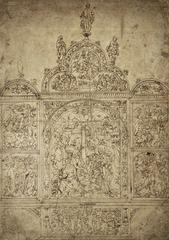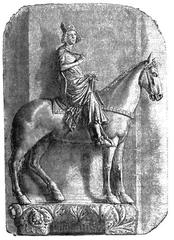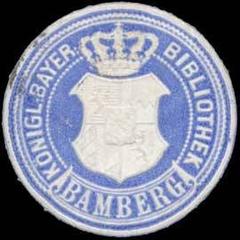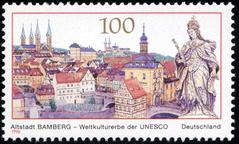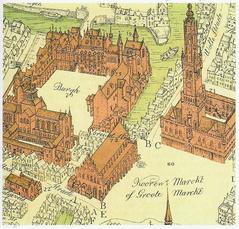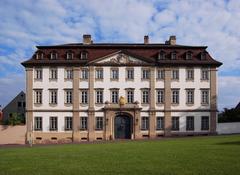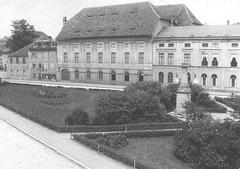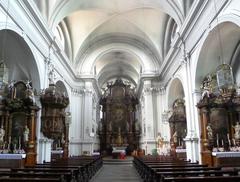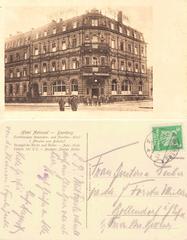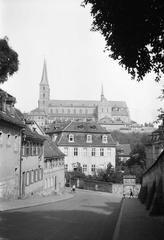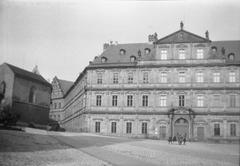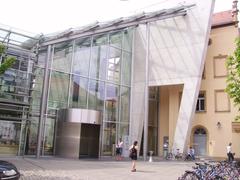Staatsarchiv Bamberg: Visiting Hours, Tickets, and Historical Sites Guide
Date: 04/07/2025
Introduction
Nestled in the heart of the UNESCO World Heritage city of Bamberg, the Staatsarchiv Bamberg is a premier institution dedicated to the preservation and study of Bavarian and Franconian history. Its roots extend back over a millennium, offering scholars, genealogists, and cultural visitors unparalleled access to the region’s documentary heritage. Housed in a striking neo-Baroque building at Hainstraße 39, the archive not only safeguards historical records but also invites visitors to explore Bamberg’s rich architectural and cultural landscape. This comprehensive guide provides essential information about the Staatsarchiv’s history, collections, visitor services, and practical tips to enhance your visit (Staatsarchiv Bamberg, GDA Bayern; Archivportal-D; Bavarikon).
Table of Contents
- Introduction
- Historical Evolution of Staatsarchiv Bamberg
- Collections and Research Opportunities
- Visiting Staatsarchiv Bamberg: Essential Information
- Exploring Bamberg: Nearby Historical Sites
- Frequently Asked Questions (FAQ)
- Contact Information
- Plan Your Visit & Stay Connected
- References
Historical Evolution of Staatsarchiv Bamberg
Origins and Development
The Staatsarchiv Bamberg traces its origins to the Prince-Bishopric of Bamberg, founded in 1007. The ecclesiastical principality played an influential role in the Holy Roman Empire, and its administrative records formed the foundation of the present-day archive (bavarikon.de). After the secularization of church lands in 1802/03, the holdings of the cathedral chapter and local monasteries were incorporated into a centralized archive housed in the Neue Residenz. Paul Oesterreicher, the last archivist of the Prince-Bishopric, was instrumental in reorganizing these materials for the new Bavarian state (archivportal-d.de).
19th and 20th Century Expansion
The dissolution of the Holy Roman Empire in 1806 and subsequent territorial shifts brought additional records from the Franconian Imperial Circle and knightly cantons into Bamberg’s custody (archivportal-d.de). The integration of the Bayreuth and Plassenburg archives between 1813 and 1818 further enriched the collections (bavarikon.de). Though the regional government seat moved to Bayreuth in 1810, the archive remained in Bamberg, underscoring the city’s enduring archival significance.
By the late 19th century, the need for a dedicated facility was clear. The purpose-built neo-Baroque archive building was completed in 1905, subsequently expanded in 1961 and 2019 to accommodate growing holdings. The archive was officially named Staatsarchiv Bamberg in 1921 (gda.bayern.de). Today, the Staatsarchiv is responsible for the documentary heritage of Upper Franconia, barring Coburg, and stands as a testament to centuries of regional administration and culture (gda.bayern.de).
Collections and Research Opportunities
The Staatsarchiv Bamberg holds approximately 2.7 million archival units, encompassing nearly 28,000 linear meters of documents (gda.bayern.de). Its collections span:
- Medieval and Early Modern Charters: Land grants, privileges, and correspondence from ecclesiastical and secular authorities.
- Administrative Records: Files from regional and local government, courts, and police, documenting governance since the 19th century.
- Ecclesiastical Archives: Church and monastery records, a vital resource for genealogical research before 1876 (Staatsarchiv Bayern).
- Maps and Plans: Historical maps, cadastral surveys, and construction drawings.
- Photographs and Personal Papers: Capturing daily life, notable figures, and significant events in Upper Franconia.
The archive is actively digitizing its holdings, with many finding aids and select documents available online (gda.bayern.de). Approximately 450,000 archival items are searchable via the digital portal, with over 5,000 digitized documents accessible to the public (archivportal-d.de).
Visiting Staatsarchiv Bamberg: Essential Information
Location and Accessibility
- Address: Hainstraße 39, 96047 Bamberg, Germany
- The archive sits on the edge of Bamberg’s historic center, within easy walking distance of other major sites (Staatsarchiv Bamberg, GDA Bayern).
Opening Hours and Admission
- Monday to Friday: 8:00 AM – 4:00 PM (some sources note 9:00 AM – 4:00 PM; check the official website for updates)
- Closed: Weekends and public holidays
- Entry: Free admission; no tickets required. Registration is necessary for reading room access.
Guided Tours and Events
- Guided tours focusing on the archive’s history and architecture are available by appointment and during special events. Check the official website for upcoming exhibitions and lectures.
Facilities and Accessibility
- Wheelchair accessible: Ramps, elevators, and accessible restrooms are available (Tourist Information Bamberg).
- Reading room: Quiet, well-lit space for research, with free Wi-Fi and staff support.
- Lockers: Provided for personal belongings.
- No on-site café: Numerous dining options exist nearby in Bamberg’s city center.
Getting There
- By Public Transportation: From Bamberg’s main train station, take bus lines 901, 902, 911, 914, 931, or 935 to the central bus station (ZOB). From ZOB, take bus 909 or enjoy a 15-minute walk to the archive.
- By Car: Limited parking; public transport is recommended.
Exploring Bamberg: Nearby Historical Sites
Bamberg’s UNESCO-listed old town is rich with landmarks. While visiting the Staatsarchiv Bamberg, consider exploring:
- Bamberg Cathedral: A masterpiece of Romanesque and Gothic architecture.
- Altes Rathaus (Old Town Hall): Famed for its unique island location and frescoed exterior.
- Historical Museum and Altenburg Castle: Offering further insight into Bamberg’s vibrant history.
- Scenic Riverwalks: Along the Regnitz River (Nomads Travel Guide; Best Places to Visit Germany).
Frequently Asked Questions (FAQ)
Q: What are the Staatsarchiv Bamberg visiting hours?
A: Monday to Friday, 8:00 AM – 4:00 PM (check the official website for any changes).
Q: Is there an entry fee or ticket required?
A: No, entry is free. Registration is required for the reading room.
Q: Are guided tours available?
A: Yes, by appointment or during special events. See the official website for schedules.
Q: Is the archive wheelchair accessible?
A: Yes, the building is fully accessible.
Q: Can I photograph documents?
A: Digital photography for personal use is permitted; flash and physical copies are generally not allowed.
Q: Where can I find genealogical records?
A: Pre-1876 ecclesiastical records are at Staatsarchiv Bamberg; post-1876 records are held by the municipal archive of the last place of residence (Staatsarchiv Bayern).
Contact Information
- Address: Hainstraße 39, 96047 Bamberg, Germany
- Phone: +49 951 98622-0
- Email: [email protected]
- Website: Staatsarchiv Bamberg
Plan Your Visit & Stay Connected
Experience Bamberg’s rich history through the Staatsarchiv and its neighboring landmarks. Stay informed on visiting hours, events, and research opportunities by following the Staatsarchiv on social media and checking the official website. Enhance your exploration by downloading the Audiala app for guided tours and up-to-date information on Bamberg’s cultural offerings.
Image recommendations for publication:
- Exterior of Staatsarchiv Bamberg building (“Staatsarchiv Bamberg building exterior showcasing historic architecture”)
- Interior reading room with visitors (“Researchers working in the Staatsarchiv Bamberg reading room”)
- Medieval charter from the archive (“Medieval charter document from the Prince-Bishopric of Bamberg held at Staatsarchiv Bamberg”)
- Map of Bamberg highlighting archive location and historical sites (“Map of Bamberg showing Staatsarchiv and key historical landmarks”)
Summary and Visitor Tips
The Staatsarchiv Bamberg stands as a dynamic intersection of history, research, and public engagement. Its extensive collections and historic building offer an immersive experience for academics, genealogists, and history enthusiasts. With free entry, modern facilities, and a prime location in Bamberg’s UNESCO old town, the archive is an essential destination for anyone interested in Franconian and Bavarian heritage. Combine your visit with explorations of Bamberg’s other treasures for a truly enriching cultural journey (Staatsarchiv Bamberg, GDA Bayern; Archivportal-D).
References and Further Reading
- Staatsarchiv Bamberg: Your Guide to Visiting, History, and Research, 2024 (Staatsarchiv Bamberg, GDA Bayern)
- Archivportal-D: Archive Stellen Sich Vor – Staatsarchiv Bamberg, 2024 (Archivportal-D)
- Bavarikon – Staatsarchiv Bamberg, 2024 (Bavarikon)
- Staatsarchiv Bamberg Visiting Hours, Tickets, and Architectural Highlights, 2024 (Porta fontium)
- Staatsarchiv Bamberg Visiting Hours, Tickets & Historical Guide to Bamberg’s Archives, 2024 (Staatsarchiv Bamberg, GDA Bayern)
- Additional resources: UNESCO World Heritage, Nomads Travel Guide, Best Places to Visit Germany, Tourist Information Bamberg

